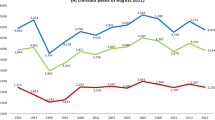Abstract
This paper develops a methodology to measure the impact of price changes on poverty measured by an entire class of additive separable poverty measures. This impact is captured by means of the price elasticity of poverty. The total effect of changes in price on poverty is explained in terms of two components, income and distribution effects. The income effect measures the change in poverty when all prices increase uniformly, whereas the distribution effect captures the change in poverty because of changes in relative prices. Using this decomposition, the paper derives an empirically operational index, which reveals whether the price changes have been pro-poor or anti-poor. The paper also derives a new price index for the poor. While this index can be computed for any poverty measures, our empirical analysis applied to Brazil is based on three poverty measures, the head-count ratio, the poverty gap ratio and the severity of poverty. The empirical analysis shows that price changes in Brazil during the 1999–2006 periods have been anti-poor. Nevertheless, during the last 2 to 3 years, the price changes have affected the poor less adversely than the non-poor.
Similar content being viewed by others
References
Amble, N., Stewart, K.: Experimental price index for elderly consumers. Month. Labor Rev. 117(5), 11–16, May (1994)
Arrow, K.J.: The measurement of price changes. In: The Relationship of Prices to Economic Stability and Growth. 85th Congress, 2nd Session, Joint Economic Committee Print. U.S. Government Printing Office, Washington, DC
Besley, T., Kanbur, R.: Food subsidy and poverty alleviation. Econ. J. 98, 701–719 (1988)
Boskin, M., Hurd, M.: Indexing social security benefits: a separate price index for the elderly. Public Finan. Q. 13, 436–449, October (1985)
Chen, S., Ravallion, M.: Welfare impact of China’s accession to the World Trade Organization. World Bank Econ. Rev. 18(1), 29–57 (2004)
Deaton, A.: Quality, quantity, and spatial variation of price. Am. Econ. Rev. 78(3), 418–431 (1988)
Deaton, A.: Rice prices and income distribution in Thailand: a non-parametric analysis. Econ. J. 99, 1–37 (1989)
Deaton, A.: Price elasticities from survey data: extensions and Indonesian results. J. Econom. 44(3), 281–309 (1990)
Deaton, A.: The Analysis of Household Surveys. Johns Hopkins University press, Baltimore (1997)
Deaton, A., Muellbauer, J.: Economics and Consumer Behavior. Cambridge University Press, New York (1980)
Diewert, W.E.: Exact and superlative index numbers. J. Econ. 4, 115–145 (1976)
Ferreira, F., Lanjouw, P., Neri, M.: A robust poverty profile for brazil using multiple data sources. Rev. Bras. Econ. 57(1), 59–92 (2003), Brazil
Foster, J., Shorrocks, A.: Sub-group consistent poverty indices. Paper presented at Warrick University Summer Research Workshop, Warrick University, U.S.A. (1988)
Foster, J., Greer, J., Thorbecke, E.: A class of decomposable poverty measures. Econometrica 52(3), 761–66 (1984)
Friedman, J., Ravinsohn, J.: The distribution impact of Indonesia’s financial crisis on household welfare: a rapid response methodology. World Bank Econ. Rev. 16(3), 397–423 (2002)
Hicks, J.R.: Value and Capital. Clarendon, Oxford (1946)
Jorgenson, D.W., Slesnick, D.T.: Individual and social cost-of-living indexes. In: Price Level Measurement, Proceedings from a Conference Sponsored by Statistics Canada (1983)
Kakwani, N.: On a class of poverty measures. Econometrica 48, 437–446 (1980)
Kokoski, M.: Consumer price indices by demographic group. Working Paper No. 167. Bureau of Labor Statistics, Washington, D.C. (1987)
Michael, R., Hagemann, R.: The variability of inflation rates across household types. J. Money, Credit, Bank. 14, 494–510 (1982)
Sen, A.: Poverty: an ordinal approach to measurement. Econometrica 44, 219–231 (1976)
Author information
Authors and Affiliations
Corresponding author
Rights and permissions
About this article
Cite this article
Son, H.H., Kakwani, N. Measuring the impact of price changes on poverty. J Econ Inequal 7, 395–410 (2009). https://doi.org/10.1007/s10888-008-9093-0
Received:
Accepted:
Published:
Issue Date:
DOI: https://doi.org/10.1007/s10888-008-9093-0




